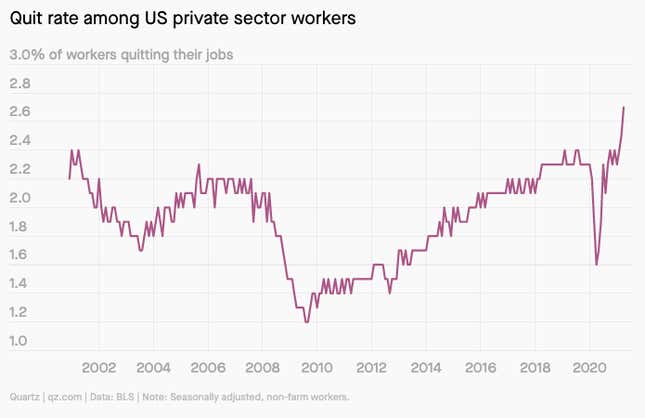To modern workers everywhere,
It’s no wonder that Apple’s plan for recalling people to the office invited backlash from employees. The plan dictated which days staff would be expected in the office (Mondays, Tuesday, and Thursdays), and made at least some employees feel their preferences were unheard if not outright ignored.
The particulars will be different at every company, but leaders everywhere are dealing with the same baseline: Previously office-bound employees are nervous about returning after more than a year of working from home.
In a recent Limeade Institute survey of 4,500 adult workers in five countries, literally every single person who worked in an office before the pandemic said they were anxious about the prospect of going back to one.
“One hundred percent anywhere in research is always shocking,” says Lindsay Lagreid, a senior advisor to Limeade, which makes employee experience software. “[T]o see this was such a profound, clear, underlined, bold exclamation point: We need to be thinking about the impact that the choices that our organizations are making right now are having on the mental and emotional wellbeing of our people.”
The bulk of people’s anxiety fell into two buckets: concern about exposure to Covid-19, which should ease as vaccination rates improve, and concern about a loss of freedom, which will be a lot harder for employers to address. The latter category includes worries about sacrificing flexible schedules, as well as the anticipated stress of going back to a regular commute. It’s all of a piece with what the experts have been telling us for years: happiness and motivation at work usually comes down to autonomy.—Heather Landy
How can managers help employees maintain a sense of autonomy while still seeing them now and again in an office? We put that question to an expert panel at our June 10 workshop on how to get the most out of hybrid. Access the replay, along with a recap of our panelists’ top tips.
Did you know that Quartz members can access all of the recordings of our Quartz at Work (from home) workshops? If you’re not yet a member, sign up now for a free trial.
Five things we learned this week
The share of US companies expecting to slash their office space is plummeting. Firms that planned to downsize their real estate during the pandemic are now rethinking their plans.
The Indian IT industry has cut its carbon emissions by 85% during the pandemic. But will it last?
America’s east coast is set to become a green energy job powerhouse. Expect a rush of approvals for offshore wind turbines.
Accent bias is an unchecked signal of racism in the workplace. Self-consciousness about accents erodes people’s self-esteem and often prevents them from speaking their mind.
The stars of the Westminster Kennel Club Dog Show put themselves up for judgment with ease. Anxious humans could learn a lot from the winning attitudes of the dogs of Westminster.
30-second case study
As the head of people and culture at the biotech company Genentech, Cynthia Burks and her team were squarely involved in management discussions about when and how to bring employees back to the office. But they didn’t take charge of the process.
“Even though I’m the head of HR for our organization, I didn’t actually lead this work,” Burks says. “I asked one of our most respected senior leaders in our organization to lead the work, because in the past when we have rolled out—and I’m sure people in HR can appreciate this—when something’s been rolled out from HR, we don’t always see the adoption we’d like to see.” So this time, “we asked the business to be involved from the very beginning.”
Even then, it took time to get everyone on the same page. “Early on we spent so much time with our leaders, really trying to understand, and helping them to understand, the assumptions they had going into this,” Burks says. “In some cases the leaders realized, you know what, actually this is just my preference—it has nothing to do with the work, I just like to see people.”
Eventually the company landed on a plan to allow everyone who was working remotely to stay remote until the end of September, ensuring maximum flexibility for the summer and during the back-to-school scramble for employees with kids. The specifics were ironed out in a cascading fashion, with company leaders formalizing an overall strategy, which became the basis for agreements for different functions within the business, which set the stage for team-level plans, followed by one-on-one conversations with employees and their managers to discuss the particulars of their work schedules.
The takeaway: In devising plans for returning (or not) to the office, it’s useful to have a central framework to guide decisions, and important to give managers and their direct reports the autonomy to select a work style that works for them. As long as the framework reflects the needs of the business, and is incorporated into the decisions about who is working where at what times, the granting of autonomy on the specifics should present few drawbacks for the company, and plenty of benefits.
In the end, a good hybrid plan represents a lot more than a sound HR policy. Ultimately, Burks says, the choices for when and where to work are “really driven by the work that’s done—the nature of the work, how do people have to collaborate, do they need to be in the office—and that really sits within the function.”
Quartz field guide interlude

“What’s most personal tends to be most universal. Hyperlocal content can still travel, but there’s a freedom in telling stories without trying to second-guess a foreign gaze.”—Candice Fangueiro, Showmax’s head of content
A global audience and increased investment are driving a boom in Africa’s film, TV, and music industries. Read more in our guide to the ascent of African entertainment.
It’s a fact!
American workers are quitting at the highest rate in decades.

This is something you might expect at the peak of an economic cycle, but now it’s happening in the midst of a recovery. It suggests that workers are confident about their ability to find better paying or appropriate employment somewhere else. But if that’s the case, why aren’t we seeing faster reductions in long-term unemployment, or more people re-entering the labor force? Quartz’s Tim Fernholz sorts it out here.
Words of wisdom
“We like the idea of digital first, rather than being hybrid or remote teams or fully in the office. However we operate, we want to operate in a digital way, meaning we capture things digitally and we’re able to circulate [information] asynchronously.”—David Barker, chief people officer, Paddle
ICYMI

Anyone with young children, aging parents, roommates, friends, pets, or a personal life is familiar with the concept of nano transitions, those moments during the day when you briefly tilt away from your work to help a family member, call a friend, or schedule a dentist appointment. (In a work-from-home context, these tiny breaks also might include unpacking a grocery delivery, letting in a repair person, or throwing the wash into the dryer.) These segues may sound like a distraction, but research shows they are key to productivity and a feeling of agency. In this gem from our archive, Quartz’s Lila MacLellan explains the power of nano transitions, and why they’ll be important to preserve as companies rewrite the rules on work schedules.
You got The Memo!
Our best wishes for a breakthrough week. Please send any workplace news, hybrid office plans, and HR non-compliance stories to [email protected]. Get the most out of Quartz by downloading our app and becoming a member. This week’s edition of The Memo was produced by Heather Landy and Sarah Todd.
